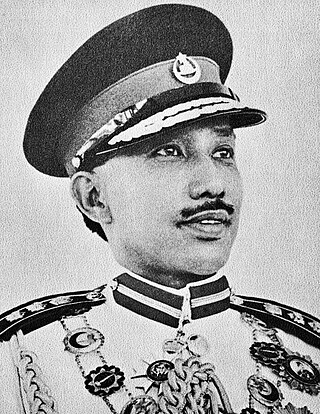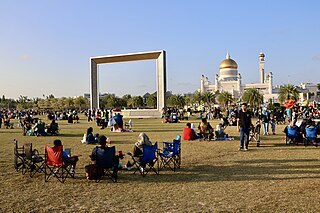The history of Brunei concerns the settlements and societies located on the north coast of the island of Borneo, which has been under the influence of Indianised kingdoms and empires for much of its history. Local scholars assume that the Islamisation of Brunei started in the fifteenth century with the formation of the Bruneian Empire, a thalassocracy that covered the northern part of Borneo and Sulu. At the end of the 17th century, Brunei subsequently entered a period of decline brought on by the Brunei Civil War, piracy, and European colonial expansion. Later, there was a brief war with Spain, in which Brunei evacuated its capital for a brief period until the Spanish withdrew. The empire lost much of its territory with the arrival of the Western powers, such as the Spanish in Luzon and Visayas and the British in Labuan, Sarawak, and North Borneo. The decline of the Bruneian Empire accelerated in the nineteenth century when Brunei gave much of its territory to the White Rajahs of Sarawak, resulting in its current small landmass and separation into two parts. Sultan Hashim Jalilul Alam Aqamaddin later appealed to the British to stop further annexation in 1888. In the same year, the British signed a "Treaty of Protection" and made Brunei a British protectorate until 1984 when it gained independence and prospered due to the discovery of oil.

Bandar Seri Begawan (BSB) is the capital and largest city of Brunei. It is officially a municipal area with an area of 100.36 square kilometres (38.75 sq mi) and an estimated population of 100,700 as of 2007. It is part of Brunei–Muara District, the smallest yet most populous district which is home to over 70 per cent of the country's population. It is the country's largest urban centre and nominally the country's only city. The capital is home to Brunei's seat of government, as well as a commercial and cultural centre. It was formerly known as Brunei Town until it was renamed in 1970 in honour of Omar Ali Saifuddien III, the 28th Sultan of Brunei and the father of Sultan Hassanal Bolkiah.

Omar Ali Saifuddien Sa'adul Khairi Waddien was the 28th Sultan of Brunei, reigning from 1950 until his abdication in 1967 to his oldest son, Hassanal Bolkiah.

Brunei–Muara District or simply known as Brunei–Muara, is the smallest as well as the most populated district in Brunei. It has an area of 571 square kilometres (220 sq mi) and the population of 318,530 as of 2021. The district is also home to its administrative centre is Bandar Seri Begawan, as well as the Brunei International Airport and Muara Port, the country's only international airport and deep-water port respectively. The Brunei River flows within this district and is home to Kampong Ayer. As the administrative center of Brunei is located in the district, it remains the most developed in the country with the most up-to-date infrastructure, despite not being the center of Brunei's main economic activity.

Muhammad Jamalul Alam II was the 26th Sultan of Brunei from 1906 until his death in 1924. He was succeeded by his eldest son Sultan Ahmad Tajuddin.
Sharif Ali or commonly known as Sultan Berkat, was the Sultan of Brunei from 1408 until 1425. He ascended the Brunei throne in 1425, succeeding his father-in-law, Sultan Ahmad, who had no male heir. He significantly strengthened Islam in Brunei through his various measures. His efforts not only enhanced his own stature but also benefited the entire Bruneian populace. By reinforcing Islamic principles, he further solidified the Malay Muslim Monarchic concept. As the first Sultan to construct a mosque in Brunei, he is regarded as a pious leader who governed the country in accordance with Islamic law.

The Sultanate of Brunei or simply Brunei, also known as the Brunei Empire, was a Malay sultanate, centered around Brunei on the northern coast of Borneo in Southeast Asia. Brunei became a sovereign state around the 15th century, when it substantially expanded after the fall of Malacca to the Portuguese, extending throughout coastal areas of Borneo and the Philippines, before it declined in the 17th and 18th centuries. It became a British protectorate in the 19th century.

Brunei Museum, the country's largest and most significant national museum, is located in Kota Batu, Bandar Seri Begawan. This national museum houses a collection spanning Islamic art, Southeast Asian history from the 16th century, and extensive displays in archaeology and ethnography. Although the museum closed in 2014 for major repairs and upgrades, its much-anticipated reopening, initially set for 2020, has been delayed and remains closed as of 2022.

The Royal Brunei Police Force, RBPF (Malay: Polis Diraja Brunei is in charge of keeping law and order in Brunei. The RBPF has been one of the 190 members of INTERPOL, an intergovernmental organisation worldwide since 1984.

Pusat Bandar is the city centre of Bandar Seri Begawan, the capital of Brunei. It is home to a number of national landmarks, important government offices, and commercial and financial establishments.

The Royal Regalia Museum is a museum located in the heart of Bandar Seri Begawan, the capital of Brunei. Originally built as a monument in 1965, the museum had a makeover and expansion in 1992 that combined constructivist and Melayu Islam Beraja (MIB) architectural elements. Originally constructed as a monument, Royal Regalia Building later underwent a transition into a museum. The building, which still has some of its original features intact, currently houses historical antiques and royal regalia from Brunei, signifying the country's rich cultural legacy and royal customs.

Hassanal Bolkiah Muiz'zaddin Wad'daulah is Sultan of Brunei since 1967, and prime minister of Brunei since independence from the United Kingdom in 1984. He is one of the few remaining absolute monarchs in the world.

Lim Jock Seng, also known as Pehin Dato Lim Jock Seng, is a Bruneian aristocrat, anthropologist, politician and diplomat who served as first Minister of Foreign Affairs & Trade II. Additionally, he was a member of the Privy Council in 2003, and Legislative Council of Brunei in 2004. Other than holding government offices, he was also the chairman of Brunei Shell Petroleum (BSP) and Royal Brunei Airlines (RBA) from 2008 to 2010.

Kota Batu is a historical as well as populated area in Bandar Seri Begawan, the capital of Brunei. It is home to the Kota Batu archaeological site, a few of the country's museums and two mausoleums of the earliest Sultans of Brunei. However, the place is still populated and at present it is a neighbourhood of the capital.

Sabah Islamic Civilisation Museum is a 2-storey museum building located at Menteri Street in Kota Kinabalu District of Sabah, Malaysia.

Brunei Energy Hub Dermaga Diraja or Brunei Energy Hub in short, is a gallery and museum located in Pusat Bandar of Bandar Seri Begawan. It was originally initiated in 1952 and completed in 1956 as the Royal Customs and Excise Building, a wharf for administrative purposes. Over time, its function has evolved to showcase historical and economic significance of Brunei's energy sector while preserving its blend of colonial and constructivist architectural styles.













